It's said that 5G's focus is on connecting people to things, and we're here to take a look at some of the predictions for 5G in 2021 and where it's heading in the near future. Read today's blog to explore some of the network's highlights and where the digital world might be taking us.

The 5G momentum has no signs of slowing down, and we’re signing that this fifth-generation technology, which was first launched by Verizon in October 2018, is getting more well-known and advanced than ever before. In fact, the future is looking brighter for 5G in 2021 and beyond, with higher bandwidth and lower latency to provide consumers with a greater quality of service.
5G 2021 and beyondHow does 5G compare to 4G?
First, let’s take a brief oversight into what 5G is exactly and how it compared to the fourth-generation network. 5G works by transforming data units over air by using a 5G New Radio interface. This process uses higher radio frequencies than 4G, transferring data at faster speeds, with lower latency, and reduced buffering. The biggest advantage of using 5G over 4G is its high performance and speed. In fact, 5G can reach 10 gigabits per second, which is around 100 times faster than 4G. This results in quicker downloads.
Not only does 5G offer a better user experience, but it also allows more devices to be used at the same time within a smaller geographic area. For example, 4G can only support around 4,000 devices per square kilometer. 5G, on the other hand, can handle around one million devices. The result is more users being able to stream online videos and the web without minimal interruptions. With these benefits already experienced at the moment, we’ll likely see improved user experienced for the consumer and business space.
How fast is 5G?
It’s the most recent network the world has seen, but exactly how fast and responsive is 5G? First, 5G can support more connective devices than other networks. With a huge number of devices in the world, 5G can power the Internet of Things like never before.
Base stations will support movement from 0–310 mph. Therefore, the base station can work even on a high-speed train, allowing you to stay connected in more areas. Radio interfaces can drop into a low-energy mode when they’re not in use. Ideally, this will be within 10 milliseconds of inactivity.
 OnePlus 8T 5G smartphone in different colors
OnePlus 8T 5G smartphone in different colors
What 5G might look like in 2021
Currently, 5G applications focus primarily on high-speed networking for mobile computer, video broadcasting, and more. As technological advancements are made, these uses will improve your everyday quality of life. This includes changing how you work and live.
5G’s expected to be bigger than ever in 2021, with more developments and advancements to the technology as well as more 5G-enabled devices. One of the biggest predictions for 5G in 2021 is seeing more developments, such as applications that utilize 5G to its best potential.
2021 is likely to welcome the idea (if not launched products) of new technological advancements, thanks to 5G. For example, Apple’s own AR glasses could be the catalyst for the next new gadget that the world becomes obsessed with. This could be a big leap in how people interact, possibly even changing the need for smartphones.
The future of the workspace with 5G
5G’s great speed will enhance employees’ productivity and workflow when working from home, allowing a more reliable connection and encouraging smoother internet use. And, with large companies relying on employees’ to work from home, a slight weakness in their security connection could pose great threats to the organizations. Since 5G offers reduced security threats—by encrypting more data—it allows you to spot potential threats easier than with previous network generations. Since we all know that a work-from-home life is likely here to stay, organizations are striving for a more secure internet connection for employees working remotely.
Moreover, blue-collar works will have more opportunities to work from home. Health care professionals can monitor patient health through wearable devices, allowing them to focus on other duties and reduce contact with patients. In addition, with the implementation of 5G, videoconference will be less likely to freeze or lag, making a more natural virtual conversation. Let’s not forget that 5G-powered technologies will improve virtual meetings, and employees could be at home but have a feeling that they’re sat around a table with other employees. You may even see holographic calls that’s powered by a 5G connection. In this case, individuals have an avatar represent them while conducting a virtual workspace. A 5G network could even allow you to collaborate on a digital whiteboard simultaneously with other employees.
Reskilling in the workspace
It wouldn’t be unlikely to see reskilling and retraining in the workspace. For example, with developments in the network, the world could see more devices and resources powered by 5G. Many jobs created by 5G—such as self-driving vehicles—would require reskilling, with possible education required. A driver couldn’t suddenly switch over to a career in handling robotic vehicles, for example.
In 2021, there are currently some companies already taking the plunge to train employees with new skills. Take Amazon, for example, is already investing $700 million to reskill hundreds of thousands of employees in machine learning and robotics.
 RedMagic 5G triple camera gaming smartphone in use
RedMagic 5G triple camera gaming smartphone in use
Industries most affected by 5G
Although some fear that the continuous development of 5G will somehow see human jobs being taken over by robots, it’s not all doom and gloom. In fact, this fifth-generation network might actually enhance your current workload and improve how you run your day-to-day operations.
Agriculture
Growers won’t have to stop what they do. Instead, 5G will help them to receive real-time data on fertilization and moisture levels. The data collected could come from drones overhead, sensors in the ground, and more. All of which would be powered by 5G.
Retail
This is probably the most feared-for industry. With 5G, customers might be able to enter their body dimensions and weight into an app and try on clothes through AR. Furthermore, smart shelves will sense when a product is running low and stock. The supply chain can then automatically send a require for a new shipment without any manual implementation.
Health organizations
5G in 2021 will likely take a step into the healthcare world. Wearable devices will allow nurses to monitor patients’ wellbeing—both physically and mentally—to provide the best care.
Transportation
One of the biggest predictions of 5G in 2021 is transportation developments. This means that 5G-powered vehicles can communicate with one another and infrastructure via a wireless network. Connected vehicles will be able to follow one another closely. Smart traffic lights and enhanced data on the current traffic flow would help o reduce congestion and reduce commutes. In fact, shipping services will likely see a huge increase in efficiency without getting stuck in traffic congestion.
Overview of 5G used for transportationImprovements to our way of life
Having faster web speeds and improved latency is all great, but 5G has the potential to make huge improvements to our way of life. Even before 5G, cities could obtain data on vehicle traffic flow, water flow, pedestrian flow, and more. But processing this data was a lengthy process due to the network capacity. Since 5G offers increase speed and bandwidth, and it has the capacity to connect to more devices at one time, this network can move and process huge amounts of data in real-time. Most importantly, the response for disasters could greatly improve. For example, helping to control the unknowns and communicate quickly and clearly to the public.
In addition, we might also see 5G looking very different in the future compared to how it looks now. This could include sending a message to your smart car to park itself in the garage. Or perhaps energy production companies using smart grids and smart monitoring to cut down on pollution and greenhouse gases. Another future example of 5G usage could include wirelessly charging your phone through the city grid as you work.
Developments of 5G so far
It doesn’t look like 5G is going anywhere any time soon. In 2020, 5G developed much faster than anyone had anticipated and, so far, 2021 has seen an expediential growth. According to Ericsson’s latest Mobility Report, 5G smartphone subscriptions will rise to 600 million by the end of 2021; that’s triple the amount from 2021. And by 2022, Statistica predicts that there will be over 1 billion users worldwide with a 5G subscription.
The benefits of 5G are exciting, but the world is already talking about the transition to 6G. This unreleased network may offer speeds that are over 100 times greater than 5G. In particular, peak data transmission speeds could reach up to. 1Tbps per person compared to 10 Gbps that’s seen in 5G. A 6G network will also blur the boundaries between virtual and reality.
Check out our article on the best 5G phones to buy in 2021, and let us know your thoughts on 5G, including any predictions you have, in the comments.





